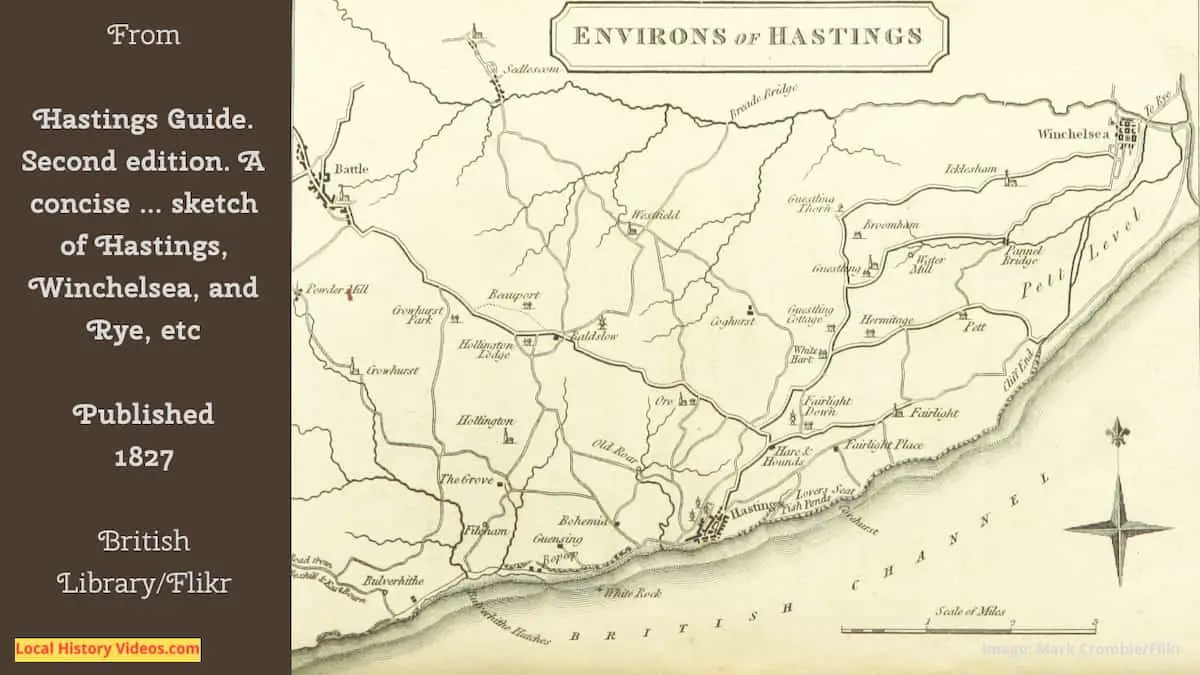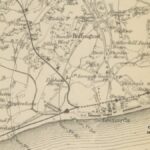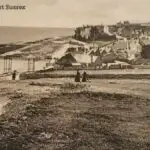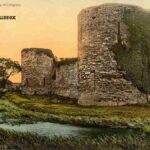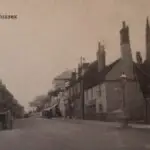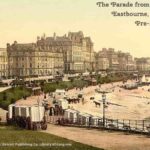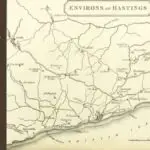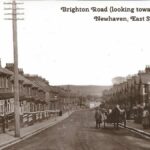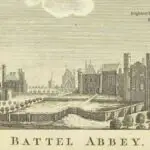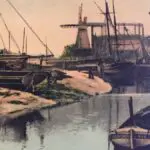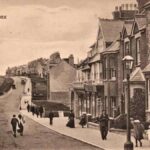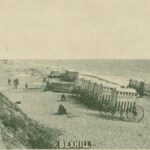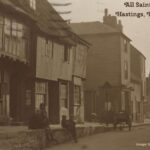Glimpse history through old images of Winchelsea, East Sussex, England.
One a key part of the UK’s medieval wine trade and a sea port of national importance, Winchelsea has been in its current location since the 13th century, when a massive flood completely destroyed Old Winchelsea in 1287 and forced the owners of more than 700 houses, two churches and over 50 inns and taverns to move.
By the twentieth century, it was a small and quiet coastal community, home today to about 600 people.
Closeup of an 1827 Map
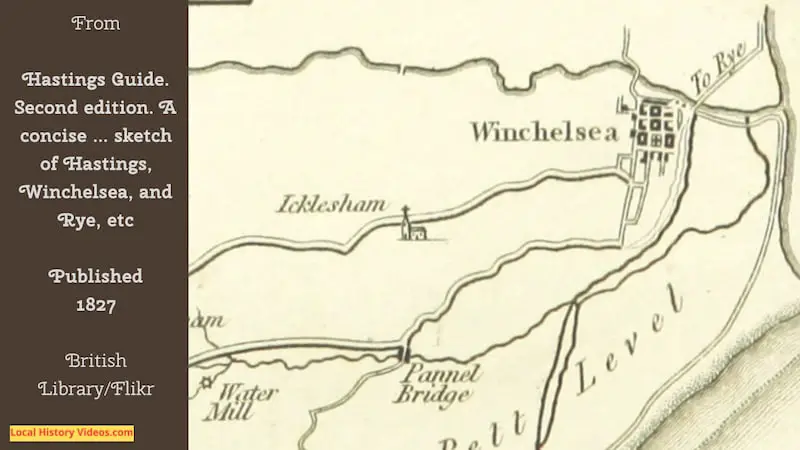
Storm Damage 1931
Gales of up to 50 miles an hour and story seas left lots of damage in what was then called a ‘bungalow town’.
Includes a nice aerial shot, before we see a home and the historic Ship Inn with their sides ripped off.
ENVIRONMENT: Storm damage in Winchelsea (1931) – British Pathé on YouTube
Historic Look Out 1936
1936 marked the 50th year that Chummy Barden had been Winchelsea’s official lookout.
For regularly scouring the coastline with his telescope, the elderly man received £1 12s 6d a year.
His Victorian clothes are there for entertainment – but think, this is the equivalent of someone appearing in 2023 in 1970s clothing!
Look OutIssue Title Is Look Out For Laughter (1936) – British Pathé on YouTube
A Bit of Winchelsea History
Extract from: The History of Winchelsea, One of the Ancient Towns Added to the Cinque Ports, by William Durrant Cooper
Published in 1850
Pages 37 – 39
Of the three original gateways , two are standing , the
STRAND GATE , formerly leading to the harbour , but now
leading by the new Military road to Rye , and the NEW GATE ,
leading on the south of Icklesham to Pett and Fairlight :
these were three quarters of a mile apart . The present roads
to Rye and across the marsh to Icklesham and Hastings were
formed at a much more recent period . We give an engraving
of these two gates . The original PIPEWELL or LAND GATE ,
now known as the FERRY GATE , led over the Ferry to the
then direct road to Rye , which was by way of Udimore .
This gate , which was situated one quarter of a mile north
west of the Strand Gate , has been re – built , and we shall have
occasion to notice the present gate hereafter .
Besides the two churches of ST . THOMAS ( the choir of
which is standing ) and ST . GILES within , and of ST . LEONARD
without the walls , the house of the GRAY FRIARS , and the
hospital of ST . BARTHOLOMEWw , which had existed in the
old town , were transferred to the new . There were also
hospitals of ST . JOHN , and of the HOLY ROOD : ¹ and there
was afterwards added , in the reign of Edw . II , a house of the
Dominicans BLACK FRIARS , or Friars Predicant . All of
which we shall describe in the chapter on Ecclesiastical
Foundations . Without New Gate stood the HOLY CROSS of
Winchelsea .
There were within the walls , two greens or open spaces ,
one of twelve acres called the KING’S GREEN , on the road
from the church of St. Thomas towards New Gate , and the
other called Cook’s GREEN , above the hanging of the hill , at
the north – east side of the town , near the Strand Gate .
Water , so scarce at Rye , was amply supplied to this town
from six open wells : -viz . , PIPE WELL , situate near the Ferry ,
close by the entrance of the town by the former Rye road :
ST . KATHERINE’S WELL , situate half way up the hill leading
from Rye , and below Cook’s Green , the water of which is
slightly chalybeate : the STRAND WELL , on the hanging of
the hill ( above the former tan yard ) destroyed a few years
since by the falling in of the cliff : the FRIARS ‘ WELL , now
enclosed , situated in a field recently called the Peartree
Wellfield , to the east of the Gray Friars ; the NEW WELL on
the outside of New Gate ; and the VALE WELL , now called
ST . LEONARD’S WELL , at the north – west of the town , under
the old castle , of whose waters the popular belief yet re
mains , that when once drunken the drinker never leaves
Winchelsea , that is , that wherever he roams his heart is still
there ; each drinker realising Goldsmith’s lines ,
In all my wand’rings round this world of care ,
I still had hopes , my strong vexations past ,
Here to return – and die at home at last .
The well – doing of the inhabitants was further secured by
two market places , called Monday’s Market and Little Mon
day’s Market , and by several Windmills . One was in the
liberty of St. Leonard , near the spot on which a windmill
now exists . Two others were within the grounds afterwards
of the Black Friars , one being near the King’s Green . There
was a stone mill near Pipewell , and a windmill in the parish of
St. Giles , in a place then called ” Le Bochery , ” now called
the Great Millbank , which , on 1st May , 1407 , Richard Lon
denays , of Brede , son of Robert de Londenays , then late of
Winchelsea , and his wife , who was sister and heiress of
William Oxenbridge , enfeoffed to John Gyles , of Winchelsea ,
miller , of whom it was purchased in 1434 , by John Godfrey ,
and came through Matilda , widow of Simon Farncombe , the
heiress of the Godfreys , in 1477 , to the abbey of Battle.
More about East Sussex
- Old Images of Wannock, East Sussex
- Old Images of St Leonards-on-Sea, East Sussex
- Old Images of Crowhurst, East Sussex
- Old Images of Rottingdean, East Sussex
- Old Images of Pevensey, East Sussex
- Old Images of Hailsham, East Sussex
- Old Images of East Sussex, England
- Old Images of Winchelsea, East Sussex
- Old Images of Newhaven, East Sussex
- Old Images of Lewes, East Sussex
- Old Images of Crowborough, East Sussex
- Old Images of Battle, East Sussex
- Old Images of the Pestalozzi Children’s Village, Sedlescomb
- Old Images of Rye, East Sussex
- Old Images of Seaford, East Sussex
- Old Images of Sidley Green, East Sussex
- Old Images of Bexhill-on-Sea, East Sussex
- Old Images of Hastings, East Sussex
- Old Images of Eastbourne, East Sussex
- Old Images of Brighton And Hove

